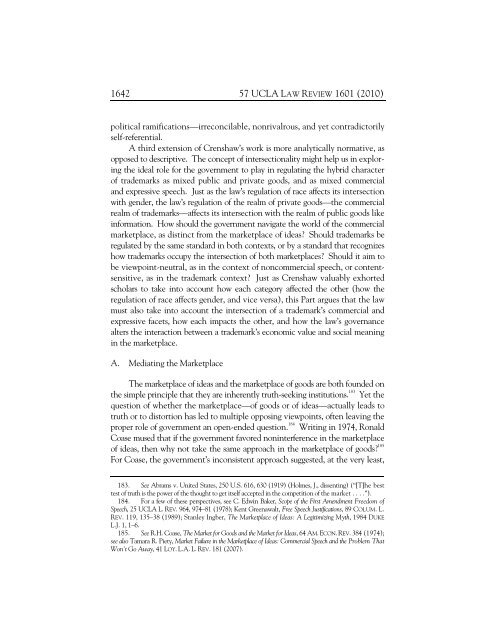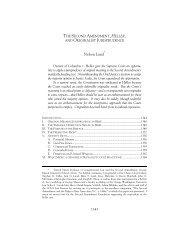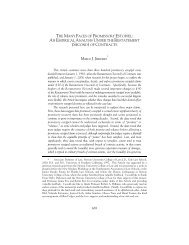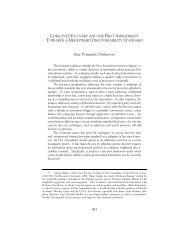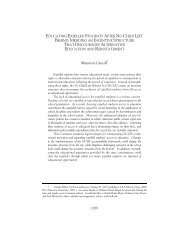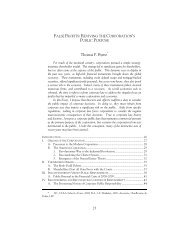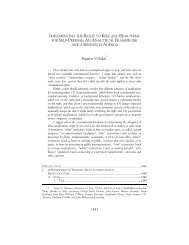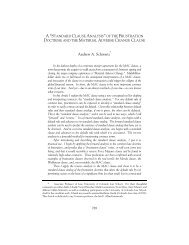Sonia K. Katyal - UCLA Law Review
Sonia K. Katyal - UCLA Law Review
Sonia K. Katyal - UCLA Law Review
You also want an ePaper? Increase the reach of your titles
YUMPU automatically turns print PDFs into web optimized ePapers that Google loves.
1642 57 <strong>UCLA</strong> LAW REVIEW 1601 (2010)<br />
political ramifications—irreconcilable, nonrivalrous, and yet contradictorily<br />
self-referential.<br />
A third extension of Crenshaw’s work is more analytically normative, as<br />
opposed to descriptive. The concept of intersectionality might help us in exploring<br />
the ideal role for the government to play in regulating the hybrid character<br />
of trademarks as mixed public and private goods, and as mixed commercial<br />
and expressive speech. Just as the law’s regulation of race affects its intersection<br />
with gender, the law’s regulation of the realm of private goods—the commercial<br />
realm of trademarks—affects its intersection with the realm of public goods like<br />
information. How should the government navigate the world of the commercial<br />
marketplace, as distinct from the marketplace of ideas? Should trademarks be<br />
regulated by the same standard in both contexts, or by a standard that recognizes<br />
how trademarks occupy the intersection of both marketplaces? Should it aim to<br />
be viewpoint-neutral, as in the context of noncommercial speech, or contentsensitive,<br />
as in the trademark context? Just as Crenshaw valuably exhorted<br />
scholars to take into account how each category affected the other (how the<br />
regulation of race affects gender, and vice versa), this Part argues that the law<br />
must also take into account the intersection of a trademark’s commercial and<br />
expressive facets, how each impacts the other, and how the law’s governance<br />
alters the interaction between a trademark’s economic value and social meaning<br />
in the marketplace.<br />
A. Mediating the Marketplace<br />
The marketplace of ideas and the marketplace of goods are both founded on<br />
the simple principle that they are inherently truth-seeking institutions. 183<br />
Yet the<br />
question of whether the marketplace—of goods or of ideas—actually leads to<br />
truth or to distortion has led to multiple opposing viewpoints, often leaving the<br />
proper role of government an open-ended question. 184<br />
Writing in 1974, Ronald<br />
Coase mused that if the government favored noninterference in the marketplace<br />
of ideas, then why not take the same approach in the marketplace of goods? 185<br />
For Coase, the government’s inconsistent approach suggested, at the very least,<br />
183. See Abrams v. United States, 250 U.S. 616, 630 (1919) (Holmes, J., dissenting) (“[T]he best<br />
test of truth is the power of the thought to get itself accepted in the competition of the market . . . .”).<br />
184. For a few of these perspectives, see C. Edwin Baker, Scope of the First Amendment Freedom of<br />
Speech, 25 <strong>UCLA</strong> L. REV. 964, 974–81 (1978); Kent Greenawalt, Free Speech Justifications, 89 COLUM. L.<br />
REV. 119, 135–38 (1989); Stanley Ingber, The Marketplace of Ideas: A Legitimizing Myth, 1984 DUKE<br />
L.J. 1, 1–6.<br />
185. See R.H. Coase, The Market for Goods and the Market for Ideas, 64 AM. ECON. REV. 384 (1974);<br />
see also Tamara R. Piety, Market Failure in the Marketplace of Ideas: Commercial Speech and the Problem That<br />
Won’t Go Away, 41 LOY. L.A. L. REV. 181 (2007).


